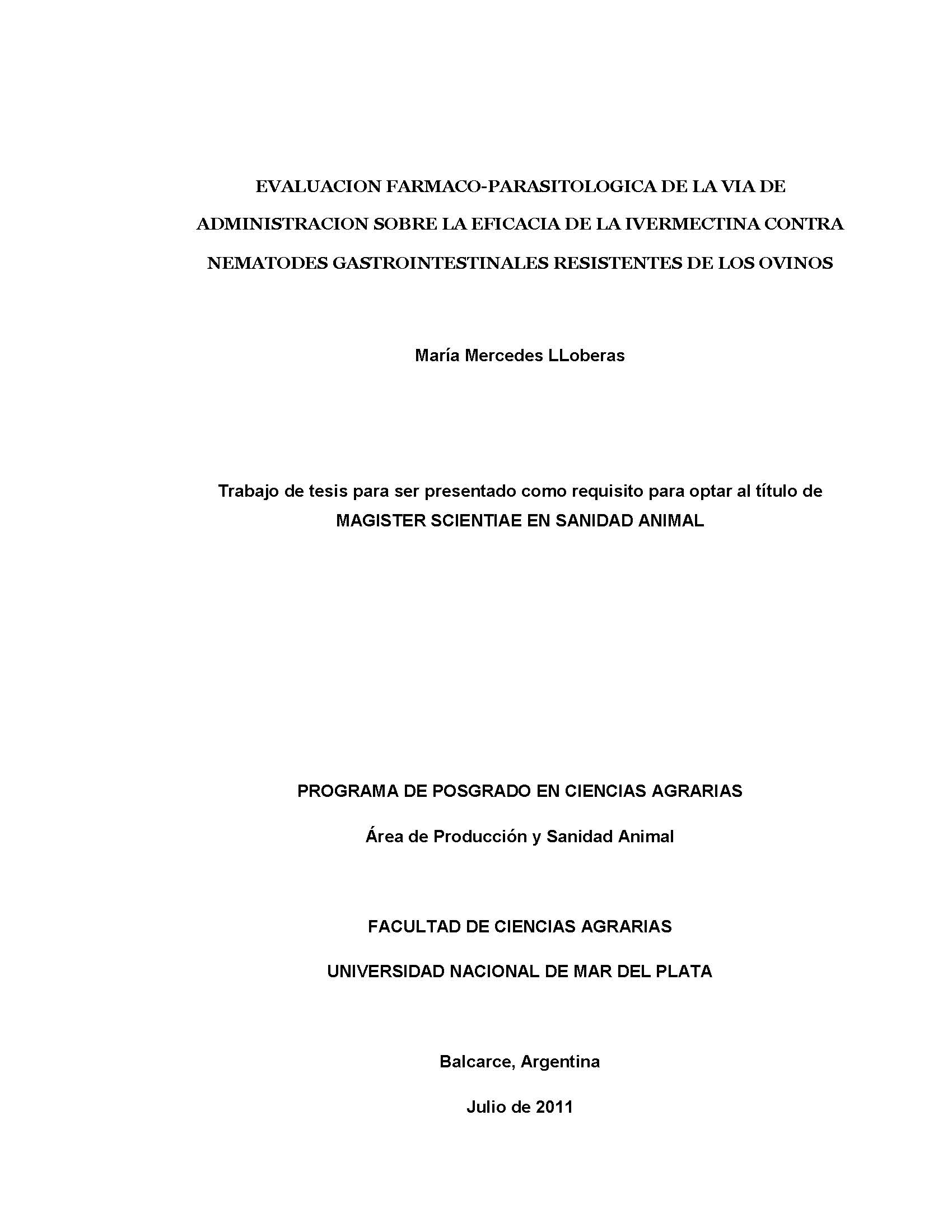Ver ítem
- xmlui.general.dspace_homeCentros Regionales y EEAsCentro Regional Buenos Aires SurEEA BalcarceTesisxmlui.ArtifactBrowser.ItemViewer.trail
Evaluación farmaco-parasitologica de la via de administración sobre la eficacia de la ivermectina contra nematodes gastrointestinales resistentes de los ovinos
Resumen
El presente trabajo de tesis abordó la Resistencia Antihelmíntica desde un enfoque integrador fármaco-parasitológico, comparando la eficacia clínica y la farmacocinética de IVM administrada por diferentes vías (subcutánea e intrarruminal) bajo condiciones estandarizadas en un mismo estudio, a corderos infestados con parásitos resistentes. Las mayores concentraciones de IVM recuperadas en el contenido gastrointestinal se correlacionaron con el incremento
[ver mas...]
El presente trabajo de tesis abordó la Resistencia Antihelmíntica desde un enfoque integrador fármaco-parasitológico, comparando la eficacia clínica y la farmacocinética de IVM administrada por diferentes vías (subcutánea e intrarruminal) bajo condiciones estandarizadas en un mismo estudio, a corderos infestados con parásitos resistentes. Las mayores concentraciones de IVM recuperadas en el contenido gastrointestinal se correlacionaron con el incremento en la eficacia obtenido después del tratamiento IR. Los resultados del presente trabajo contribuyen a optimizar el uso de IVM en el control antiparasitario en ovinos
[Cerrar]
The present thesis work studied the anthelminthic resistance from a pharmaco- parasitological perspective, comparing the clinical efficacy and pharmacokinetics of IVM administered by different routes (subcutaneous e intrarruminal) to lambs infected with resistant parasites. Twenty six (26) lambs were divided into 3 groups: control (n = 6) without treatment, IVM SC (n = 10) (IVM subcutaneously at 0.2 mg/kg) and IVM IR (n = 10), IVM IR (IVM intraruminally
[ver mas...]
The present thesis work studied the anthelminthic resistance from a pharmaco- parasitological perspective, comparing the clinical efficacy and pharmacokinetics of IVM administered by different routes (subcutaneous e intrarruminal) to lambs infected with resistant parasites. Twenty six (26) lambs were divided into 3 groups: control (n = 6) without treatment, IVM SC (n = 10) (IVM subcutaneously at 0.2 mg/kg) and IVM IR (n = 10), IVM IR (IVM intraruminally at 0.2 mg/kg). For the parasitological study, individually feces samples were taken, pre and post treatment (pt). These samples were used for the determination of fecal eggs counts per gram (epg), fecal culture and larvae identification. At day 15 pt, six animals per group were sacrificed, for counting and identification of adult parasites in the digestive tract. Jugular blood samples were obtained for pharmacokinetic studies, between 0 hour and day 14 pt. Additionally, four animals of SC and IR group were sacrificed at day 3 pt and samples of gastrointestinal content and mucosa and Haemonchus contortus were taken. IVM concentrations were quantified by HPLC. Pharmacokinetic analysis was performed using the PKsolutions (Summit Research Services USA) and pharmacokinetic parameters were compared using t test. Adult parasites and hpg results were analyzed by non-parametric methods. The reduction of the hpg increased from 45% (SC) to 51.7% (IR). The percentage of IVM effectiveness by parasitic gender was always greater in the IR group. Efficacies in abomasal parasites were 52.4% (SC) and 81.9% (IR). Treatments showed an efficacy of 95.2% (SC) and 99.9 (IR) for intestinal nematodes. H. contortus proved to be highly resistant to treatment by both routes of administration, efficacy increased from 0% (SC) to 40% (IR) treatment. IVM availability in plasma was higher (p≤ 0.05) after the SC administration. However, the IVM concentration in gastrointestinal contents was higher in IR treated lambs .The ratio between concentration of IVM measured in abomasum content and mucosa was 0.07 (SC) and 2.97 (IR). Drug concentrations observed in H. contortus were 14.4 times higher after IR administration compared those observed after SC treatment, reflecting the importance of the environment in which the parasite is located. The largest concentrations of IVM recovered in gastrointestinal contents correlated with the increased efficacy obtained after IR treatment. The current Thesis contributes to optimize the use of IVM and therefore the parasite control in sheep.
[Cerrar]

Director de Tesis
Lifschitz, Adrian Luis (Director);
Descripción
Tesis para obtener el grado de Magister Scientiae en Sanidad Animal, presentada en la Facultad de Ciencias Agrarias de la Universidad Nacional de Mar del Plata, en Julio de 2011.
Fecha
2011-07
Editorial
Facultad de Ciencias Agrarias, Universidad Nacional de Mar del Plata
Formato
pdf
Tipo de documento
tesis de maestría
Palabras Claves
Derechos de acceso
Abierto
 Excepto donde se diga explicitamente, este item se publica bajo la siguiente descripción: Creative Commons Attribution-NonCommercial-ShareAlike 2.5 Unported (CC BY-NC-SA 2.5)
Excepto donde se diga explicitamente, este item se publica bajo la siguiente descripción: Creative Commons Attribution-NonCommercial-ShareAlike 2.5 Unported (CC BY-NC-SA 2.5)


